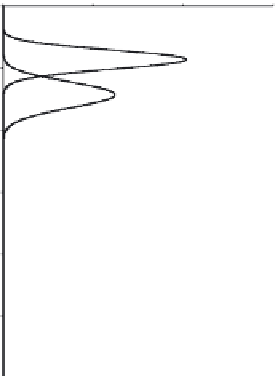Agriculture Reference
In-Depth Information
which is known as the Freundlich equation. Incorporation of the linear form
into the CDE yields:
∂
∂
C
t
∂
∂
S
t
∂
∂
∂
∂
C
z
−υ
∂
C
z
+
=
D
(3.39)
z
∂
where
S
is given by the Freundlich equation. The Freundlich equation does
not yield an equivalent retardation factor (see Equation 3.37), which is useful
in assessment of travel time and depth. Nevertheless, a nonlinear form of the
retardation factor can be expressed as:
=+
ρ
θ
b
R
K
C
(3.40)
f
where some arbitrary or average concentration may be used. As discussed
in Chapter 1, other sorption processes, including Langmuir, first-order, and
n
th-order kinetics are incorporated into the sorption term of the right-hand
side of Equation 3.40.
In Figure 3.6, the movement of a solute in soils having different retarda-
tion factor
R
in Equation 3.37 is presented. Figure 3.6a shows a comparison
of solute distribution for a nonreactive (
R
= 1) and a reactive (
R
= 2 and 4)
solute, which clearly illustrates the effect of solute retention as depicted
Concentration (mg/L)
Solute Sorbed (mg/Kg soil)
0
25
50
75
0
25
50
75
0
0
R = 4
R = 4
25
25
R = 2
R = 2
50
50
75
75
100
R = 1
100
R = 1
125
125
150
150
FIGURE 3.6
Solute concentration and the amount sorbed versus depth for different values of linear retarda-
tion factor
R
. For nonreactive solutes (
R
= 1) there was no solute sorption with depth.



Search WWH ::

Custom Search